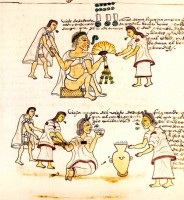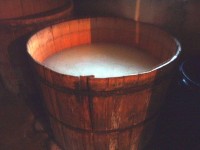 Pulque is tequila’s ancient ancestor, with reports of its creation ranging from ancient Africa to as late as the 16th century. The drink’s history extends far back into the Mesoamerican period, when it was considered sacred, and its use was limited to certain classes of people. The name “pulque” is derived from Nahuatl. The original name of the drink was “iztac octli” (white wine), the term pulque was probably mistakenly derived by the Spanish from the “octli poliuhqui” which meant “spoiled wine”. The name pulque, sometimes known as octli, is a milk-colored, somewhat viscous alcoholic beverage made from the fermented sap of the maguey plant, and is a traditional native beverage of Mexico. There are about six varieties of maguey that are best used for the production of pulque. The Spanish Conquistadors fermented and brewed pulque at first due to the absence of beer, wines, rums and brandy. Hidden archeology is debated with some people believing evidence of Pre-hispanic distillation in ancient China and Africa, but remains highly debated. Fermentation takes place by a complex succession of yeast and bacteria that produce ethanol, a diversity of chemical compounds, and some polymers that give a sticky consistency to the final product. Pulque is sometimes mixed with fruits or vegetables, but has poor stability as it is neither distilled nor pasteurized.
Pulque is tequila’s ancient ancestor, with reports of its creation ranging from ancient Africa to as late as the 16th century. The drink’s history extends far back into the Mesoamerican period, when it was considered sacred, and its use was limited to certain classes of people. The name “pulque” is derived from Nahuatl. The original name of the drink was “iztac octli” (white wine), the term pulque was probably mistakenly derived by the Spanish from the “octli poliuhqui” which meant “spoiled wine”. The name pulque, sometimes known as octli, is a milk-colored, somewhat viscous alcoholic beverage made from the fermented sap of the maguey plant, and is a traditional native beverage of Mexico. There are about six varieties of maguey that are best used for the production of pulque. The Spanish Conquistadors fermented and brewed pulque at first due to the absence of beer, wines, rums and brandy. Hidden archeology is debated with some people believing evidence of Pre-hispanic distillation in ancient China and Africa, but remains highly debated. Fermentation takes place by a complex succession of yeast and bacteria that produce ethanol, a diversity of chemical compounds, and some polymers that give a sticky consistency to the final product. Pulque is sometimes mixed with fruits or vegetables, but has poor stability as it is neither distilled nor pasteurized.
 It is not known who invented pulque. Its origins go back at least 1,000 years. Various stories and myths have developed as to its origins. Most involve Mayahuel, the goddess of the maguey. It was thought that the aguamiel collecting in the center of the plant was her blood. Other deities, such as the Centzon Totochtin (400 rabbits) are associated with it, by representing the drink’s effects, and are the children of Mayahuel. Another version involving Mayahuel has her as a mortal woman who discovered how to collect aguamiel but someone named Pantecalt discovered how to make pulque. Another story states that pulque was discovered by the Tlacuache (opossum), who used his human-like hands to dig into the maguey and extract the naturally fermenting juice. He became the first drunk. Tlacuache was thought to set the course of rivers. The rivers he set were generally straight except when he was drunk. Then they follow Tlacuache’s meandering path from cantina to cantina. Another story traces the discovery of aguamiel to the Toltec Empire, when a noble named Papantzin was trying to get the emperor to marry his daughter Xochitl. He sent her to the capital with an offering of aguamiel. The emperor and princess wed, and their son was named Meconetzin (maguey boy). In other versions of the story, Xochitl is credited with discovering pulque.
It is not known who invented pulque. Its origins go back at least 1,000 years. Various stories and myths have developed as to its origins. Most involve Mayahuel, the goddess of the maguey. It was thought that the aguamiel collecting in the center of the plant was her blood. Other deities, such as the Centzon Totochtin (400 rabbits) are associated with it, by representing the drink’s effects, and are the children of Mayahuel. Another version involving Mayahuel has her as a mortal woman who discovered how to collect aguamiel but someone named Pantecalt discovered how to make pulque. Another story states that pulque was discovered by the Tlacuache (opossum), who used his human-like hands to dig into the maguey and extract the naturally fermenting juice. He became the first drunk. Tlacuache was thought to set the course of rivers. The rivers he set were generally straight except when he was drunk. Then they follow Tlacuache’s meandering path from cantina to cantina. Another story traces the discovery of aguamiel to the Toltec Empire, when a noble named Papantzin was trying to get the emperor to marry his daughter Xochitl. He sent her to the capital with an offering of aguamiel. The emperor and princess wed, and their son was named Meconetzin (maguey boy). In other versions of the story, Xochitl is credited with discovering pulque.
 Pulque first officially appears on stone carvings about 200 AD. The first major work involving pulque is a large mural called the “Pulque Drinkers” which was unearthed in 1968 during excavations at the pyramid of Cholula, Puebla. The most likely means of the discovery of aguamiel and fermented pulque was from the observation of rodents who gnaw and scratch at the plant to drink the seeping sap. Fermentation of the aguamiel can take place within the plant itself.
Pulque first officially appears on stone carvings about 200 AD. The first major work involving pulque is a large mural called the “Pulque Drinkers” which was unearthed in 1968 during excavations at the pyramid of Cholula, Puebla. The most likely means of the discovery of aguamiel and fermented pulque was from the observation of rodents who gnaw and scratch at the plant to drink the seeping sap. Fermentation of the aguamiel can take place within the plant itself.
Pulque’s mysterious past continues to fascinate modern day people, and its legend grows with each passing day. The new century’s love of tequila is raising interest in other agave born products such as mescal and pulque, with the ancients interest in the use of pulque in rituals of particular interest to modern day tequila aficionados.
What did pulque mean to the Indians of the Mexican central highlands? Click here to find out.



